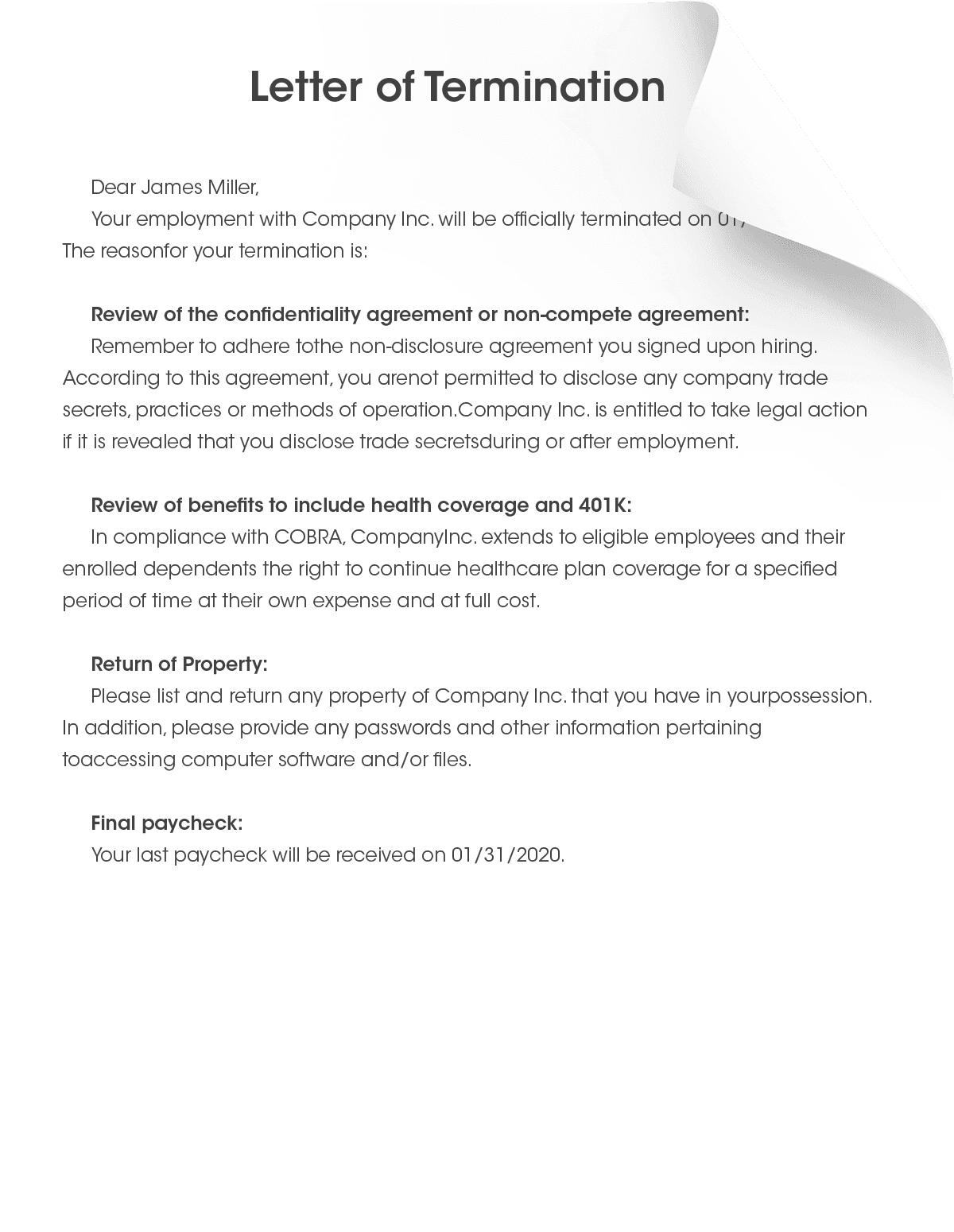What is an Employee Termination Letter?

A letter of termination is a formal document issued by an employer to an employee to end their employment. It outlines the reasons for the termination, provides essential details such as the employee’s final paycheck, benefits, and any obligations to the employer. A well-crafted employee termination letter ensures clarity and professionalism, making the process smoother for both parties involved.
There are various types of termination letters depending on the circumstances of the separation. For example, some letters address performance issues, while others deal with layoffs, contract completion, or misconduct. As a business manager, writing a professional and in-depth termination letter is critical to maintaining compliance and minimizing disputes.
Why Do You Need to Use a Termination Letter?
An employment termination letter serves as a record of the employee’s termination. It documents the details surrounding the separation and can act as evidence in case of any future legal disputes. Keeping a termination letter in the employee’s file is a best practice for maintaining transparency and protecting the company.
Additionally, a termination of employment letter ensures that the employee is informed about their rights, benefits, and responsibilities after leaving the organization. It eliminates ambiguities and prevents misunderstandings that could arise in the absence of a formal document.
When Do You Need to Use a Employee Termination Letter?
Using a termination letter should be standard practice whenever an employee’s contract is being ended. Whether the termination is due to downsizing, resignation, or other reasons, presenting an official letter of termination of employment is crucial for maintaining a professional process. The letter helps clarify expectations and ensures both parties are on the same page.
Are there deadlines for providing a Employee Termination Letter?
Yes, a termination letter should be provided promptly upon the employee’s termination. Ideally, the employer should go over the letter’s contents with the employee during the termination meeting, addressing any questions or concerns they might have. Providing the letter at the right time helps maintain a professional and respectful approach to what can often be a sensitive situation.
What are the Main Elements of an Employment Termination Form?
A termination letter to an employee should include the following key elements:
1) Employee and Company Details: The letter should clearly state the employee’s name and the company’s name to avoid any confusion.
2) Reason for Termination: Depending on the circumstances, this can range from performance issues to company restructuring.
3) Final Paycheck Details: Specify the date the employee will receive their final paycheck and any additional compensation, such as unused vacation pay.
4) Benefits Information: If applicable, outline details about health benefits, such as COBRA options or retirement plan information.
5) Employee Obligations: Reiterate any non-compete agreements, confidentiality clauses, or other contractual obligations.
6) Acknowledgment of Receipt: Ensure the employee signs and dates the letter to confirm their understanding of its contents.
What Mistakes Should You Avoid When Drafting a Termination Letter?

Creating a termination letter requires professionalism and care. Avoid these common pitfalls:
- Unclear Language: Be direct and transparent. Vague statements can lead to misunderstandings.
- Lack of Sensitivity: Termination is a difficult process, and the tone of the letter should reflect respect and empathy.
- Non-Compliance: Ensure your employment termination letter aligns with state laws, HR policies, and any agreements outlined in the employee handbook.
Easily Create Your Employment Termination Letter Today
You don’t need a lawyer, accountant, or notary to create a termination letter. Our platform allows you to generate a legally sound termination of employment letter quickly and affordably, saving you time and money. With our intuitive system, you can avoid expensive professional fees while still producing a document that meets all legal requirements.
Creating a letter of termination of employment is simple with our step-by-step process. The document is tailored to your needs, ready for download immediately, and can be revised at any time. Whether you need one or multiple termination letters, our system ensures you have the flexibility and control to make adjustments as necessary.
Choose FormPros for convenience, security, and peace of mind. Our termination letter generator helps you create professional, legally binding documents with ease. Enjoy features like:
- Ease of Use – No legal expertise required.
- Error-Free Documentation – Minimize mistakes with guided form completion.
- 100% Privacy and Security – Your data is encrypted and safe.
- Unlimited Access – Generate as many letters as needed with our subscription plan.
- Satisfaction Guarantee – We stand by our service with a 100% money-back guarantee.
Start creating your employment termination letter today and experience how simple and efficient the process can be.
Create a Termination Letter Now
Simplify your paperwork with FormPros! From creating paystubs, W-2s, and 1099-MISC forms to generating LLC Operating Agreements and even voided checks, our easy-to-use platform has you covered. Save time, reduce errors, and handle your business documents with confidence. Start now and see how FormPros makes professional form generation fast, affordable, and hassle-free!
Employee Termination Letter FAQs
-
Is a termination letter legally required?
Termination letter requirements vary by jurisdiction. Some states or countries mandate providing written notice, while others do not. Even where it’s not required, a termination letter is a best practice to document the process and reduce potential disputes.
-
Can an employee refuse to sign the termination letter?
Yes, an employee can refuse to sign a termination letter. In such cases, the employer should document the refusal and proceed with the termination process, ensuring the letter is added to the employee’s file with a note about the refusal.
-
What happens if a termination letter contains errors?
Errors in a termination letter, such as incorrect dates or inaccurate reasons for termination, can lead to confusion and legal challenges. Employers should review the letter carefully to ensure it is accurate and compliant with labor laws.
-
Should a termination letter include details about unemployment eligibility?
While it is not required, some employers include information about unemployment benefits or direct employees to the appropriate resources. Employers should avoid making definitive statements about eligibility since this is determined by state agencies.
-
How should termination letters be delivered?
Termination letters can be delivered in person, via email, or through certified mail. In-person delivery is ideal, as it allows for immediate clarification. If in-person delivery isn’t feasible, ensure the letter is sent securely.
-
Are termination letters required for layoffs?
While not always legally required, providing termination letters during layoffs helps communicate the reasons for the layoff, any severance package details, and other relevant information, maintaining transparency.
-
Should the termination letter mention severance pay?
Yes, if severance pay is being offered, the letter should clearly outline the amount, payment schedule, and any conditions tied to receiving it, such as signing a release agreement.
-
Can termination letters be customized for different situations?
Yes, termination letters should be tailored to the specific circumstances of the termination. For example, the content for layoffs differs from letters addressing misconduct or performance issues.
-
How long should employers retain termination letters?
Employers should retain termination letters as part of the employee’s file for several years, as required by local labor laws or company policies. These records may be necessary for audits, disputes, or legal compliance.
-
Is it necessary to involve HR in creating termination letters?
Yes, involving HR ensures the termination letter complies with labor laws, company policies, and best practices. HR can also help avoid tone or content issues that may inadvertently escalate the situation.





